Emerging Markets Need More Veterinary Products, Here are 5 Trends Why

Contents Overview
The global animal healthcare market was valued at $43.55 billion USD in 2018. It is estimated that the market will grow to $70 billion USD by the year 2026. The animal healthcare industry is seeing growth not only in the pet sector but also in livestock healthcare prevention and treatment. It is expected that investors and distributors alike will jump on the opportunity and ensure their business growth by expanding their product scope and range to satisfy the booming veterinary industry. Especially in the developing world, where the veterinary industry, just as healthcare and medicine demand for humans, is also expecting the fastest growth. More specifically, the global increase in the veterinary healthcare industry is driven by Asian-Pacific, Latin American, Middle Eastern and African regions. Alongside the increased demand in livestock production and pet ownership, increased risk of animal diseases, especially in farm animals is also one of the key factors showing the clear need of better access to animal healthcare.
The veterinary healthcare market provides the availability of treatment for domestic and farm animals. Today, it is driven by increased adoption and care for companion animals, and a higher demand for livestock production. With globalization, living standards have improved and more and more developing markets are looking for productive, sustainable and better quality food sources as consumers are expressing their need for better food to improve health and well-being.
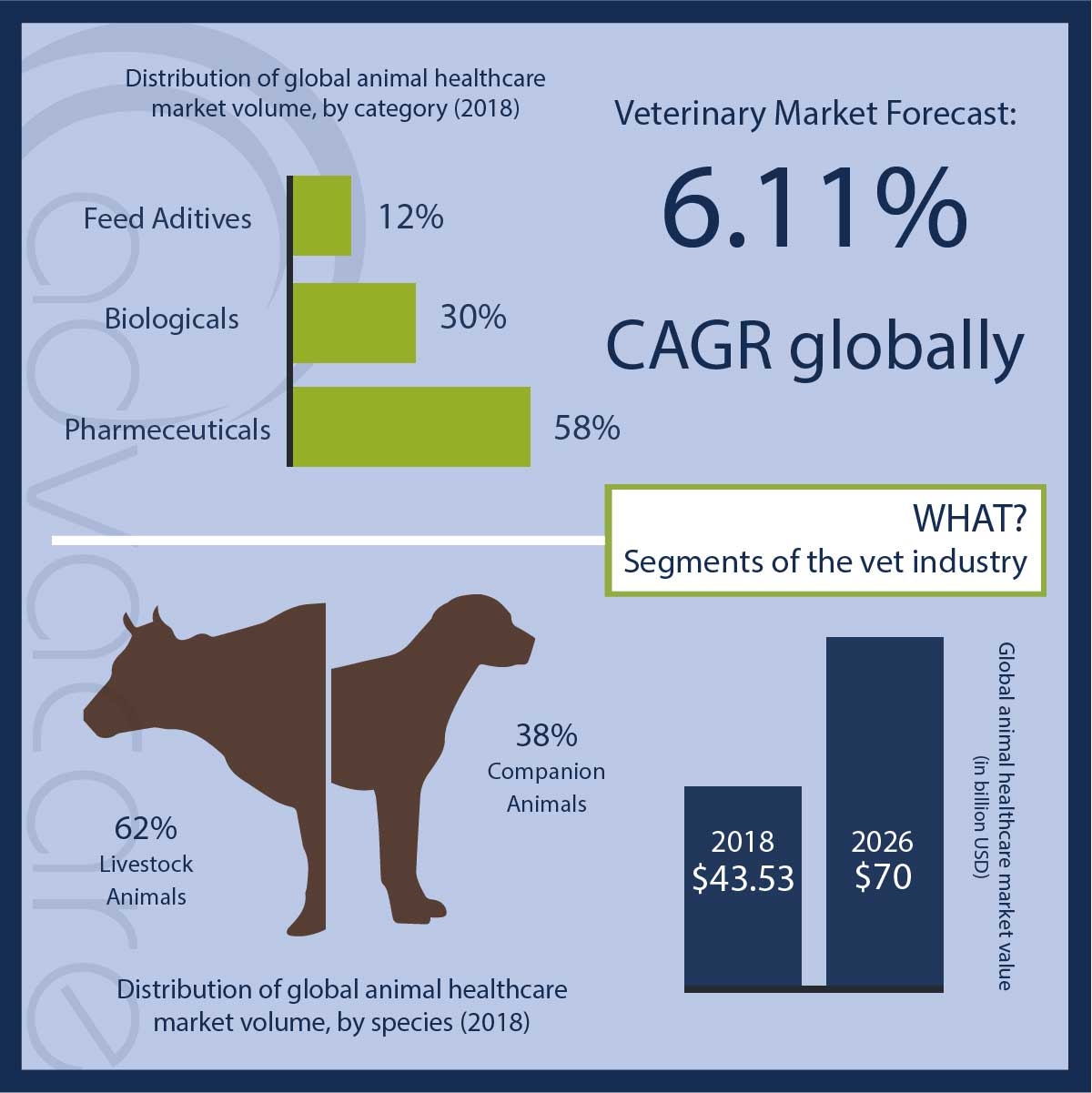
To achieve the needs and concerns in the industry, governments across the globe are, therefore, calling for more advances in veterinary health and agricultural practices. It can be said that the animal health industry is in the era of significant transitions. When flows of the industry are being reorganized, many opportunities for new business involvements are arising. Before considering new market entry, it is still important to know how it is segmented, even though growth can be seen overall across different segments. For the animal healthcare industry, the segmentation can be done in various ways: by animals, products, and regions.
This being said and looking at the market by species, the demand growth of livestock production has slowed down, while pet ownership and demand for animal companion healthcare continues to grow.
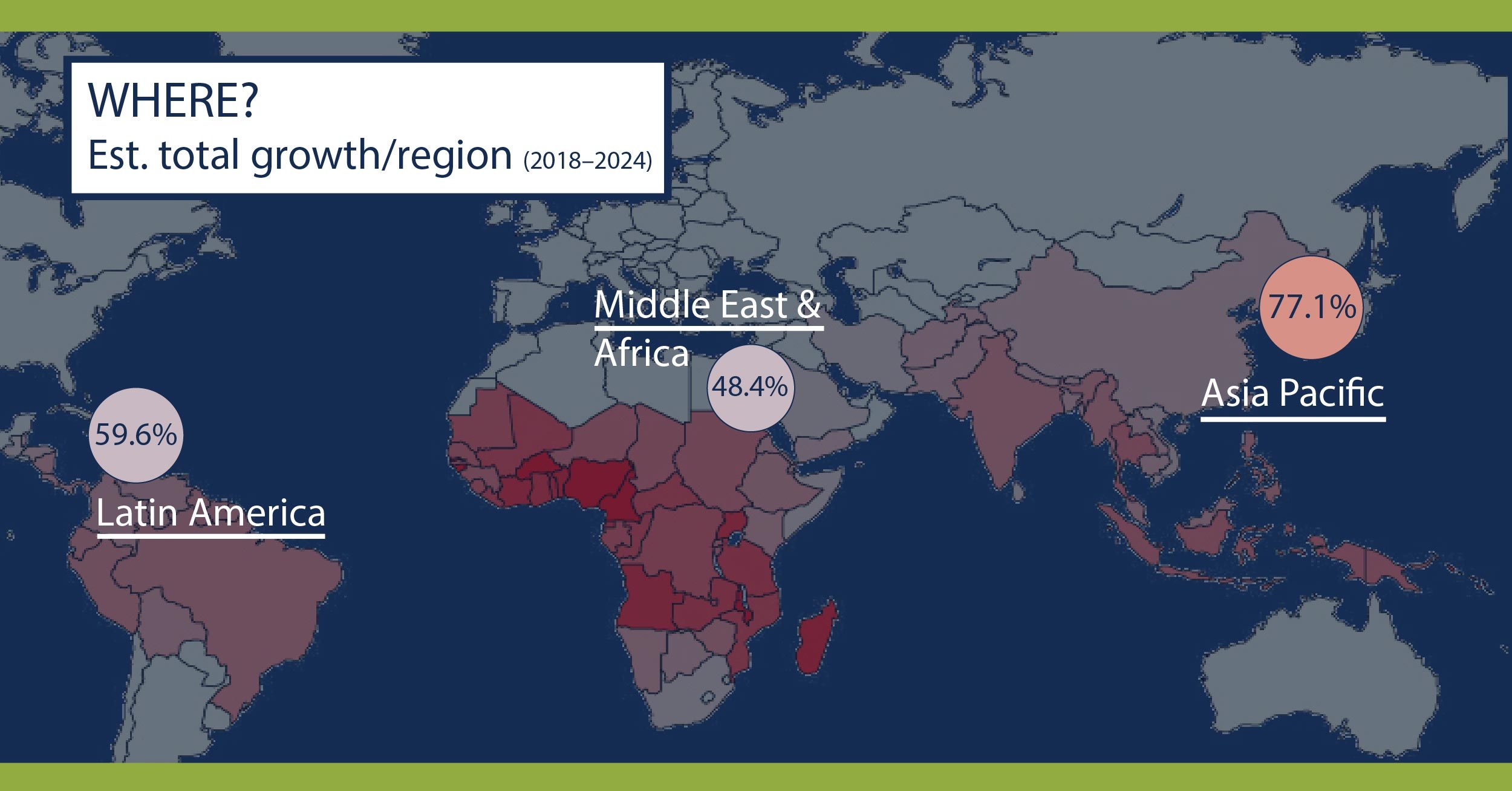
Statistical data and overview of the veterinary industry only, however, do not give enough justice to the high market potential of animal healthcare products distribution. To deeply understand the extent of growth opportunities a distributor of medicine may have, one should focus on trends of the markets. Here are five, currently affecting the industry flow, especially in the developing countries.
Trend #1
The Increased Consumption of Meat and Milk are Affecting Livestock Production Patterns
Global population is expected to reach 9.7 billion by 2050, representing more than a 25% increase from 7.6 billion marked in 2018. Such rapid growth of the global population clearly shows an urgency for the food supply expansion. Yet globally, livestock production already accounts for about 40% of the gross value of agricultural production. However, the number gets much lower, to only one-third of the gross value, if we only take developing countries into account. On the opposite, populations, as well as the demand for bigger food supplies, are growing significantly faster in those regions than in the developed world.
FAO estimates that the total demand for animal products in developing countries will more than double by 2030
Consequently, livestock production statistics are expected to slowly change its patterns, as developing countries will have to quickly pick up the pace and rise toward the global average in order to meet the increasing demands in their markets.
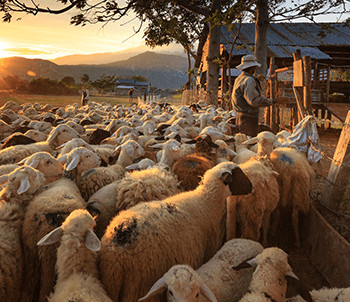
According to a study, carried out by FAO (Food and Agricultural Organization of the United Nations), the total demand for animal products in developing countries is expected to more than double by 2030, and with the consistent growth, the livestock sector will soon exceed that of the crop sector.
As a result of the rapid growth in animal-based food production, demands for veterinary feed additives, animal healthcare sector services and technological advancements in the livestock production are also rising.
For example, the feed additive segment held a dominant market share of 39.05% in 2018, according to an industry report on veterinary services. The most probable reason why such a high demand for feed additives exists on the market is the fact that additives have a significant effect on the animals’ muscle growth, and can thus also optimize feed utilization. Since governments are also inclined to the enhancement of veterinary health, additives like vitamins, antioxidants, and performance promoters are permitted and encouraged to be used in feed internationally.
Trend #2
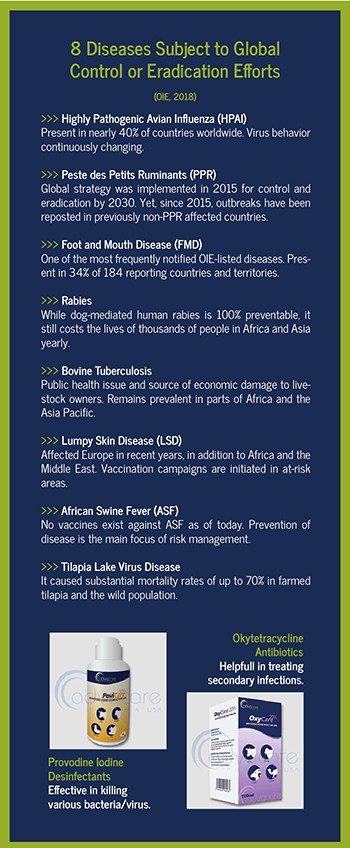
Animal Diseases Present an Immense Threat to Economy
Besides increasing demand for preventive healthcare treatment of livestock animals, in order to optimize the quality and/or quantity of final animal products for the market, curative treatment of animals with specialized animal medicine, is also in demand.
Cases of major livestock disease outbreaks are unfortunately still occurring globally and resulting in significant economic damages. Moreover, an even bigger danger is any disease also affecting human health through contact or consumption of unhealthy animal products (zoonoses). In all this, the trend toward antibiotic resistance in humans as well as animals does not help, but only increases the number of global threats to humans and animals.
Fortunately, veterinary vaccines have long been an important part in protecting animal health against highly infectious diseases such as rabies, parvovirus, parvovirus, distemper, hepatitis, E.coli and brucellosis. In addition to disease prevention, vaccinations are also reducing animal suffering, and are enabling efficient production as well as reducing the use of antibiotic treatments. They have also been the most important measure in prevention against livestock diseases and zoonoses. However, not only vaccinations but also other alternative products such as probiotics, prebiotics, and immune modulators, are gaining popularity among veterinarians and farmers. Inevitably, diseases can still occur even when taking the right prevention steps. In the case of an animal falling ill, quick and reliable detection is the first step to an effective treatment. After the diagnosis, medicine must be administered promptly, especially in the cases of highly infectious diseases.
This being said and looking at the market by species, the demand growth of livestock production has slowed down, while pet ownership and demand for animal companion healthcare continues to grow.
Overall, increasing livestock demand and production will be met with increasing demand for veterinary healthcare products. Particularly in developing regions, a gap in the market for high-quality and effective veterinary pharmaceuticals still exist, mainly because medicine is not affordable for every farmer.
Overall, increasing livestock demand and production will be met with increasing demand for veterinary healthcare products
Additionally, there is a lack of information on the positive effect of proper animal/livestock healthcare, which only hinders the use of recent veterinary medicine advancements in those regions. Now that, on the other hand, leaves many doors open for new distributors of affordable high-quality veterinary products. Thus, efforts to provide the community different ranges of livestock medicine will likely fall on fertile grounds.
Trend #3
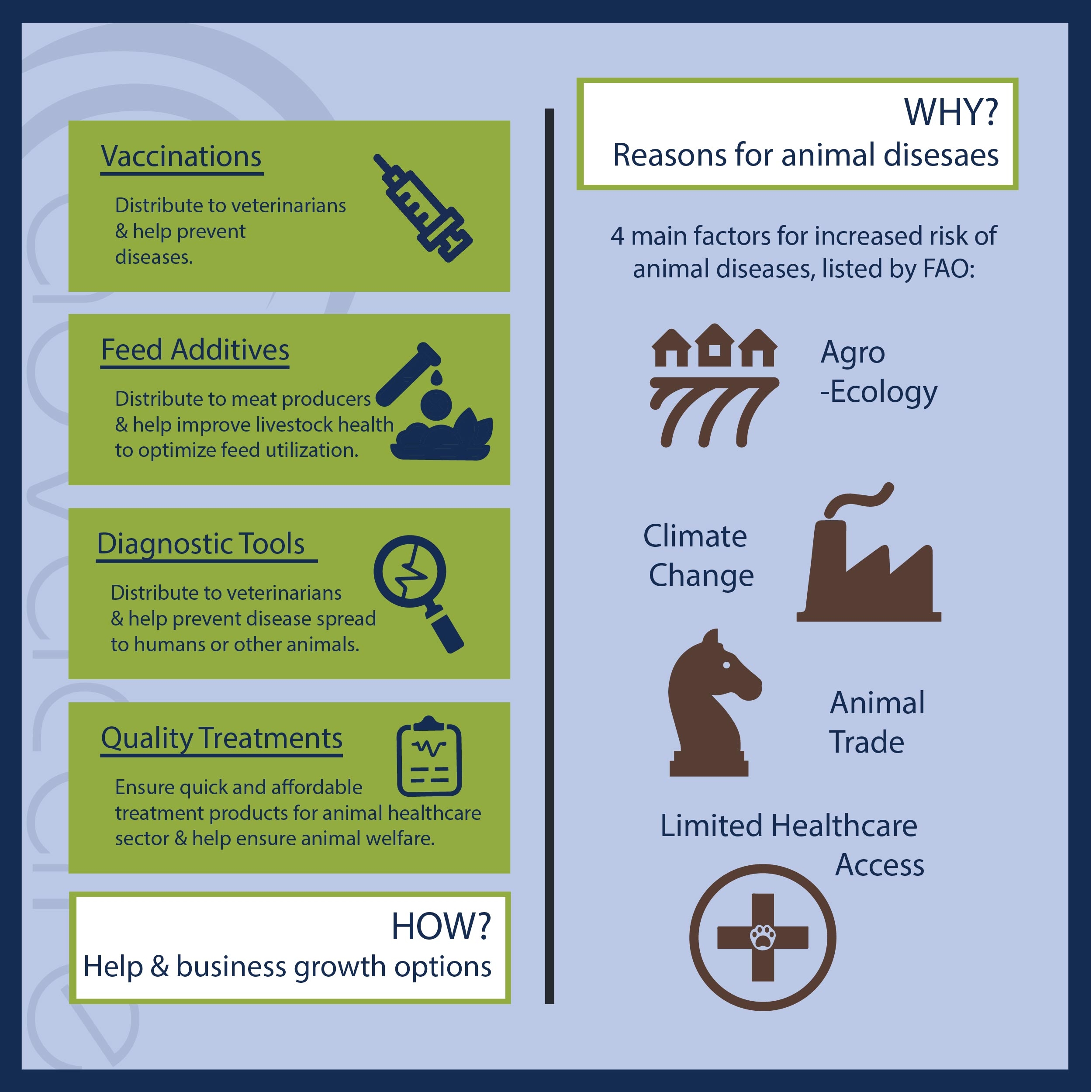
Veterinary Treatments Are Increasingly Being Encouraged by Government Initiatives
It is presumed the growth in the veterinary healthcare market is driven by government initiatives for enhancement of agricultural practices and veterinary health. European Union can serve as an example from the developed world, where certain additives such as vitamins, antioxidants, and performance promoters are permitted and recommended to use in feed.
In developing nations around the world, governments are prioritizing the development of multi-specialty veterinary hospitals and clinics, in order to ensure a better disease control and animal treatment
In developing nations around the world, governments are prioritizing the development of multi-specialty veterinary hospitals and clinics. With a hope to ensure better disease control and animal treatment, the initiatives are not only driven by good practice examples from the West, but also by major livestock disease outbreaks. In China, for example, the biggest animal disease outbreak the world has ever faced happened recently, when a deadly pig virus, called African Swine Fever, infected up to 200 million pigs. Also, it has not been long since Europe faced an outbreak of avian flu influenza or Bird Flu, which is still not eradicated. According to CIDRAP (Center for Infectious Diseases Research and Policy), the virus has recently been observed in China, Nepal, Iraq and Cambodia.
In light of historic outbreaks and efforts to stop them, FAO – one of the most important bilateral organizations focusing on food security – pointed out four risk factors for animal diseases. They include agro-ecology, climate change, animal trade, and limited healthcare access. Many are affecting areas in developing countries, making cases of animal and zoonotic disease outbreaks more common and easily transmittable. Yet simultaneously, most areas in emerging economies still lack access to specialty veterinary hospitals or advanced pharmaceutical products for effective treatments.
Trend #4

The Increase in Pet Ownership is Leading to More Demand of Pet Medicine and Supplements
Did you know that owning a dog can be tied to lowering your risk of dying early by 24%? Not only dogs but animal companions in general, are also said to improve overall mental and physical health by generating a sense of calmness, resulting in more regulated breathing, lowered blood pressure and pulse rate. Several studies have observed better health outcomes in people sharing their home with an animal, rather than those that don’t. Recently, a systematic review of several types of research concluded there is a significant reduction in the risk of death for pet owners. In fact, besides cardiovascular health, it can also help with depression.
Pet ownership is rising rapidly in developing countries, proven by a 51% increase of dog and 49% of cat ownership from 2003 to 2017
However, with benefits of pet ownership, also come responsibilities. Ensuring timely and regular healthcare at the veterinary clinic if one of them. And while families in the Western world have been embracing the companion animals’ role in the house for many years now, the same was not the case in developing markets. There, livestock animals were given higher importance. This fact is now changing. Pet ownership is rising rapidly in developing countries, proven by a 51% increase of dog and 49% of cat ownership from 2003 to 2017. Consequently, the animal healthcare market segment, from veterinary products to services, will have an annual growth rate of around 7.4% in the next few years.
Besides increasing numbers of companion adoptions among families, another key contributing factor for the pet healthcare industry growth is the increase of awareness among the owners about the benefits of animal preventative care. In fact, better veterinary diagnostic methods can today effectively diagnose many pet diseases and lead to better and correct treatment. One example of this is the ELISA test, effective for heart-worm diagnosis. Aside from this, the focus is shifting to pet dietary supplements as a key preventative measurement, especially for age-related health issues. One of the most popular products are nutraceuticals for joint support, containing ingredients such as glucosamine, MSM or Boswellia. Additionally, there is also a lot of promise in the use of probiotics for digestive support, and fatty acids for seasonal allergies.
Since consumers are being educated on benefits of supplementation for humans, they are noticeably seeking out similar products for their animals as well. In fact, human supplements have been actually taking the market by storm. Discover 4 reasons why in our previous article here.
Trend #5
Livestock and Pet Welfare Has Gained Significant Momentum
Good animal welfare, according to American Veterinary Medical Association (AVMA) requires disease prevention and veterinary treatment, appropriate shelter, management, nutrition, humane handling and humane slaughter.
Good animal welfare requires disease prevention and veterinary treatment, appropriate shelter, management, nutrition, humane handling and humane slaughter

Fortunately, there has been an increased awareness in animal welfare. Driven by globalization and social media, more people than ever before are now not only transforming to conscious, more demanding consumers of dairy products and animal produces, but are also becoming fierce advocates for animal rights and welfare. With the ease of information availability online, general public can now better understand what are the sources of the products used in everyday life, and pick the products they buy accordingly. Furthermore, increasing concerns have moved the industry to provide better disease prevention, veterinary treatment, and nutrition.
Better awareness in animal welfare is also not limited to farm animals. Various non-profit organizations worldwide have taken initiatives for stray animals like dogs or cats. It is true, that the first approaches used to control the numbers of stray animals in developing nations were electrocution or euthanasia. Yet, they were proved ineffective, and in many developing nations in the world, the nonlethal approach of sterilization has been presented as a better alternative by a number of organizations. Some examples of participating countries are India, Nepal, Philippines, Afghanistan, Ethiopia, Mexico, and Peru. Aside from population control of stray animals, the initiative is also a chance to tackle a significant health problem stray animals present. For example, approximately 30,000 to 50,000 people die from rabies each year, as a result of a dog bite. The vast majority of cases happens in developing nations, as reported by The Humane Society organization. By providing vaccinations coupled with the sterilization, the communities, not only animals, are therefore protected from transmissible diseases.
Learn more about why supplying veterinary products to developing markets has become a business growth opportunity in our sources for the article: “Animal welfare: an asset for livestock production” Bulletin by OIE; “The Future Of Animal Health” article by Forbes; “Dog Ownership and Survival” a systematic review and meta-analysis by Caroline K. Kramer, Sadia Mahmood and Renee S. Suen; “Livestock infectious diseases and zoonoses” research by Fiona M. Tomley and Martin W. Shirley; “Global Animal Health Market To Reach USD 70.01 Billion By 2026” press release by GlobalNewsWire; “Veterinary Industry Outlook: Top Global Trends and Statistics” article by The Business Research Company; “Veterinary Services Market Analysis Report By Animal Type” report overview by Grand View Research; “Animal Health Market Size, Share & Trends” report overview by Grand View Research; “We're Currently In The Biggest Animal Disease Outbreak Of All Time” article by IFL Science; “The Growing Pet-Supplements Market” article by Nutritional Outlook; “Veterinary Healthcare Market - Growth, Trends, And Forecast (2019-2024)” report overview by Mordor Intelligence; “Four countries report avian flu outbreaks in poultry” article by CIDRAP; “Slumdogs by the Million” article by The Humane Society; as well as various FAO resources on livestock production, animal welfare and veterinary products accessible on their official web page and “World agriculture: towards 2015/2030” report.
Don't want to miss the next AdvaCare article?

Recommended Content

Trillion-Dollar Reason Why You Should Supply Supplements to Emerging Markets

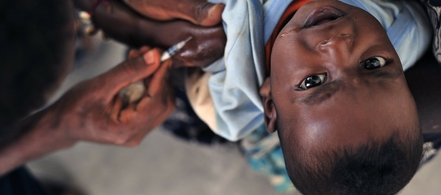
Pharma & Medical Distribution Continue to Thrive in Emerging Markets — Learn How You Can Benefit


5 Infectious Disease Outbreaks Were not Contained in 2019, What Can You Learn from it?
